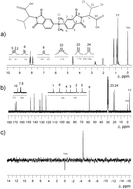Silicon-containing oligomeric poly(imido-amides) with amino moieties. Synthesis, characterization and thermal studies
Abstract
Silicon-containing oligomeric poly(imido-amides) (PIAs) were synthesized from dicarboxylic imido-acids containing a Si atom, which were obtained from dianhydrides and the amino acids glycine, L-alanine, L-phenylalanine, L-valine, L-leucine, L-isoleucine and p-aminobenzoic acid (I–III-(a–g)), were polymerized with the diamine bis(4-aminophenyl)diphenylsilane. Monomeric dicarboxylic imido-acids and PIAs were characterized by IR and 1H, 13C and 29Si NMR spectroscopy and, when necessary, optical rotation, and the results were in agreement with the proposed structures. The yields were very good, greater than 90%, but the ηinh values were low, indicating that PIAs were of oligomeric nature, especially those derived from dicarboxylic imido-acids with aromatic groups bonded to the Si central atom. PIAs were soluble in polar aprotic solvents, and also in other organic solvents like m-cresol, tetrahydrofuran, and several in CHCl3 and acetone, due to the inclusion of Si atoms and amino acidic residues in the main chain. The glass transition temperature (Tg) values were obtained by DSC, and showed a tendency in the sense that when the side chain of the amino acidic residue is increased, the Tg values decrease, as the higher volume of the side chain implies a higher chain separation and consequently a higher free rotation of them. PIAs including glycine or p-aminobenzoic acid residues, without side groups, showed higher Tg values due to an increase of the molecular rigidity. The thermal stability was determined by dynamic thermogravimetry showing that almost all PIAs were thermally stable, with TDT10% values greater than 400 °C. The most stable PIAs were those including the p-aminobenzoic residue in the main chain. The groups, methyl or phenyl, bonded to the Si atom of the carboxylic imide-acids residue did not show an important influence. The UV-vis transparency was studied showing that the increase of the aromatic content decreases the UV-vis transparency. PIAs derived from carboxylic imide-acids containing only phenyl groups bonded to the Si atom, were non-transparent.


 Please wait while we load your content...
Please wait while we load your content...